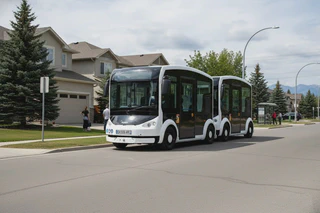Modular Buses for the Suburbs of Calgary
 Image credit: Reza Mahmoudi
Image credit: Reza Mahmoudi
Table of Contents
Overview
CLIENT
City of Calgary, Calgary Transit the municipal public transport agency
LOCATION
Calgary, Alberta, Canada
Role
Designer, Planner
Markets
Transit & Rail
Transportation Market
Solutions
Modular Bus
Emerging Transit Technology
Transit Planning
Sustainability
Transportation Services
Regions
Calgary Metropolitan Region
Our Client’s Challenge
Calgary is a city in the Canadian province of Alberta. As of 2021, it had a population of 1,306,784 within the city proper and 1,481,806 in the metropolitan area, making it the third-largest city and fifth-largest metropolitan region in Canada.
Calgary Transit, the city’s public transit agency, operates a range of services including LRT, BRT, local bus routes, on-demand transit, and paratransit. While express transit services such as LRT and BRT are widely used and well-received, several local bus routes continue to underperform, showing low ridership levels. Typically, Calgary Transit operates a mix of small and large buses on these routes, using larger buses during peak hours and smaller or medium-sized vehicles during off-peak periods.
Despite this mixed-fleet strategy, underutilized capacity remains high, leading to substantial operational and capital costs. Supported by a grant from the Government of Canada and the Government of Alberta, this project explored a futuristic alternative for the city: modular buses. The modular vehicle concept allows the size of buses to be dynamically adjusted by coupling or uncoupling vehicle units, offering greater flexibility and efficiency.
This project focused on several key objectives:
- Critical Assessment: Evaluating alternative options for serving suburban areas using different types of buses.
- Scenario Development: Defining specifications and characteristics for future demand scenarios, fleet compositions, and capital cost structures.
- Data-Driven Solution: Applying analytical and data-driven methods to conduct a comparative study among three fleet configurations: fixed-size vehicles, mixed-size fleets, and modular buses.
- Stakeholder Reporting: Documenting and presenting results to various stakeholders to inform future planning and policy decisions.
Our Solution
In this project, we focused on feeder transit services in suburban areas, which primarily connect passengers to and from the city’s mass transit network, such as the LRT. Using a combination of provided datasets and several stated preference surveys conducted by the Transportation Engineering Group in the Department of Civil Engineering at the Schulich School of Engineering, University of Calgary, we developed replicable, data-driven models that the city can use to evaluate three alternatives for any transit route in any suburban area. The proposed solutions were designed to balance user costs, accessibility, environmental impact, and transit agency expenses, ensuring a robust and sustainable outcome.
To account for potential demand shifts and induced demand, we expanded the analysis across multiple scenarios to determine how long a proposed solution would remain robust under changing conditions. We also developed pessimistic scenarios, including situations such as a pandemic outbreak similar to COVID-19, and re-evaluated the solutions under those circumstances to assess their resilience.
 Figure: The modular vehicle concept allows the size of buses to be adjusted by coupling or uncoupling vehicle units .
Figure: The modular vehicle concept allows the size of buses to be adjusted by coupling or uncoupling vehicle units .
Recommendations and Policy Implications
The findings have several important implications for transit planning and policy:
- Perceived Costs Influence the Solution: For a conventional bus fleet, cost parameters directly impact the required fleet size. However, in the case of modular vehicles (MVs), fleet size and service frequency remain stable despite changes in users’ perceived crowding costs or the agency’s dispatching costs.
- Modular Buses Address Unused Capacity: Implementing a modular fleet can substantially reduce the number of unused seats. In some suburban routes, our analysis showed that modular buses could decrease unused capacity by up to 94%.
- Modular Buses Offer a Robust Solution: A modular fleet remains the optimal choice with a lower total system cost, even when dispatch costs per seat are up to 10% higher, for demand levels ranging between 15 and 1,000 passengers per hour.